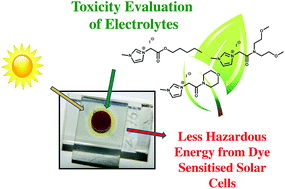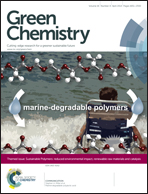Low toxicity functionalised imidazolium salts for task specific ionic liquid electrolytes in dye-sensitised solar cells: a step towards less hazardous energy production†
Abstract
Novel solvent free task specific ionic liquid (TSIL) electrolytes for dye sensitised solar cells (DSSC) were synthesised and tested. Of great concern is the replacement of low-moderate toxicity second generation ILs, with high toxicity third generation TSILs. As most 1-butyl-3-methylimidazolium (Bmim) and especially 1-ethyl-3-methylimidazolium (Emim) based ILs have low toxicity, the designing of replacement TSILs of comparable toxicity is a challenge. Structural features of TSIL investigated herein were incorporation of heteroatoms into the side chain of imidazolium cations (i.e. ether, ester and amide) and anion (bromide, iodide, and triflimide [NTf2]). Preliminary toxicity screening against 20 microorganisms (8 bacteria and 12 fungi) found that all ILs, imidazolium salts, N-butylbenzimidazole (NBB) and guanidinium thiocyanate (GNCS) do not exhibit high antimicrobial toxicity. However NBB and a pentyl ester substituted IL displayed moderate toxicity to several strains of bacteria and fungi. Further toxicity testing to establish IC50 values shows several novel TSIL compounds and imidazolium salts are in fact less toxic to microorganisms (e.g. bacteria) than commonly used 1-ethyl-3-methylimidazolium iodide (EmimI) and 1,3-dimethylimidazolium iodide (DmimI). We have demonstrated that the presence of ether and either ester or amide groups in the structure of the cation of the TSIL and imidazolium salts reduces antimicrobial toxicity, which is consistent with the lowering of the lipophilicity of ILs. Iodide and bromide analogues have lower toxicity than the NTf2 examples in this study. The DSSC performance using these “greener” ILs in place of the standard EmimI compare quite favourably. Two low antibacterial toxicity iodide examples exhibit photocurrents of 9.27 mA cm−2 and 8.85 mA cm−2, respectively, achieving promising efficiencies of 3.39% and 3.31%, respectively (EmimI = 4.94%). DSSC performance is further improved by 15% minimum to 66% maximum, depending on IL chosen, by the presence of small amounts of moisture and DSSCs employing a low antibacterial toxicity iodide TSIL or imidazolium salt can surpass the performance of dry EmimI. Of note the DSSC containing TSIL NTf2 examples, performed poorly compared to the halide analogues, with the outcome that the most toxic TSILs under investigation are also the least preferred based on performance.


 Please wait while we load your content...
Please wait while we load your content...